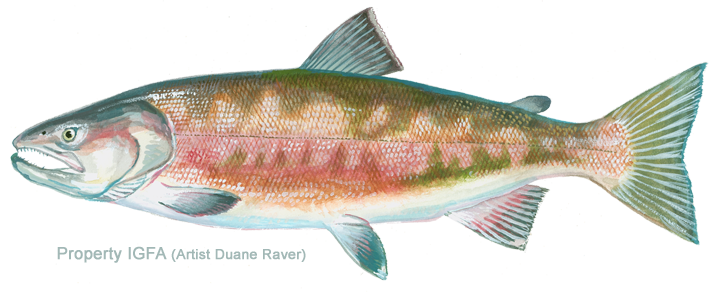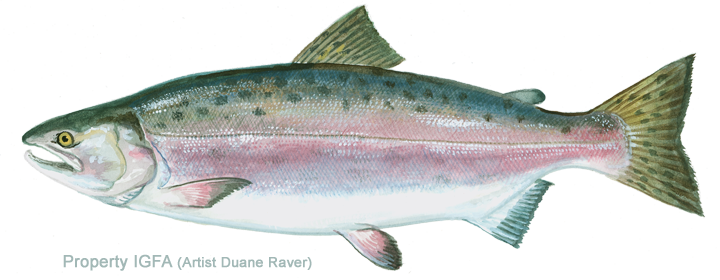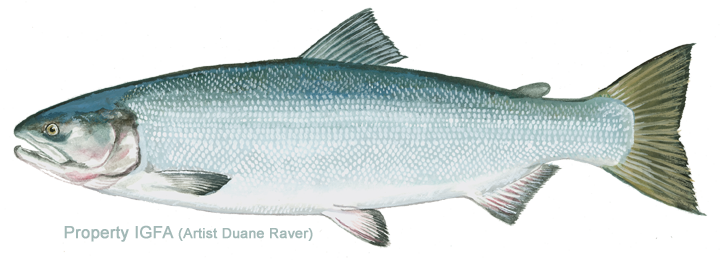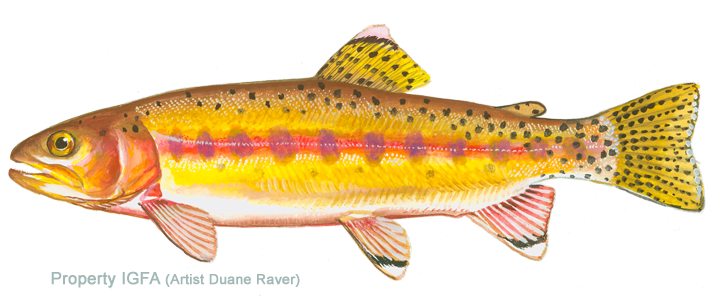Game Fish Identification Reference Guides
Trout, rainbow
(Oncorhynchus mykiss)
(Oncorhynchus mykiss)
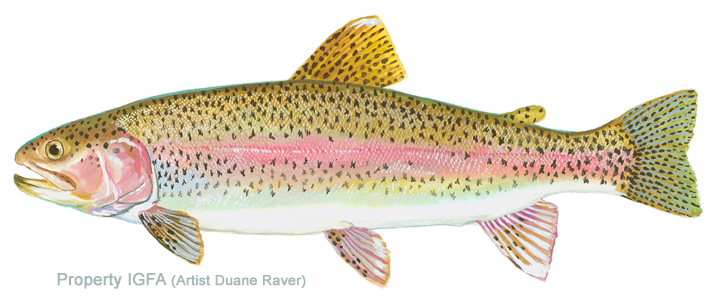
(Walbaum, 1792); SALMONIDAE FAMILY; also called steelhead, Kamloops, redband trout, Eagle Lake trout, Kern River trout, Shasta trout, San Gorgonio trout, Nelson trout, Whitney trout, silver trout
It is native to the west coast of North America from southern Alaska to Durango, Mexico and inland as far as central Alberta in Canada and Idaho and Nevada in the U.S. It has been extensively introduced across the lower Canadian provinces and throughout the area of the Great Lakes to the Atlantic coast, south in the Appalachians to northern Georgia and Alabama, east in the southern U.S. to western Texas and sporadically in the central U.S. as well as above the Great Lakes on the Atlantic coast. It has been transplanted to New Zealand, Australia, South America, Africa, Japan, southern Asia, Europe and Hawaii. An Asian species known as the Kamchatka trout is believed to be a form of the rainbow trout. It is native to the Amur River in the eastern part of Russia as well as Kamchatka and the Commander Islands.
Coloration varies greatly with size, habitat and spawning periods. For example, stream dwellers and spawners usually show the darkest and most vivid colors and markings, while the steelhead is silvery when it returns from the sea. Though noted for the broad red or pink stripe along the middle of its sides, this stripe may not be present on all forms, particularly the sea run steelhead and immature specimens in clear lakes. A similar stripe is sometimes present on the golden trout (Oncorhynchus aguabonita) and the cutthroat trout (O. clarki), though the golden trout usually has about 10 prominent parr marks on the sides through adulthood (uncommon but not unheard of in adult rainbows). The cutthroat can usually be distinguished by the yellow, orange, or red streak in the skin fold on each side under the lower jaw. In some waters rainbow trout may faintly display this streak in the skin fold, but most do not.
The rainbow and its closest relatives in the Pacific salmon group (cutthroat, golden, Mexican golden, Arizona native or Apache, and gila trout) are known as the “black spotted” trouts because they are covered with numerous prominent black spots. These spots may cover the entire body or may be more abundant near the tail. The spots characteristically extend onto the dorsal fin, the adipose fin, and the tail. Those on the tail radiate outward in an even, orderly pattern. Spots may or may not be present on any of the lower fins and there are never any red spots such as occur on freshwater and spawning specimens of brown trout (Salmo trutta) and Atlantic salmon (S. salar). The rainbow trout readily hybridizes with other “black spotted” trout, especially with the cutthroat and golden trout. In fact, all these trout hybridize wherever they occur together producing fertile offspring with all manner of confusing color combinations and intermediate characteristics.
This is an extremely valuable species in any and all of its forms. It is the fly fisherman's delight as it takes a fly readily, leaps often, and fights hard. Though there is no direct commercial demand for the rainbow it is taken by Pacific salmon fishermen and it is pond reared in Europe and Japan to be sold as frozen whole fish. The flesh ranges from bright red in small lake and stream populations to pink or white in large lake, stream, and steelhead populations in which the diet is primarily piscivorous. It is excellent regardless of color and may be cooked in any manner desired
It is native to the west coast of North America from southern Alaska to Durango, Mexico and inland as far as central Alberta in Canada and Idaho and Nevada in the U.S. It has been extensively introduced across the lower Canadian provinces and throughout the area of the Great Lakes to the Atlantic coast, south in the Appalachians to northern Georgia and Alabama, east in the southern U.S. to western Texas and sporadically in the central U.S. as well as above the Great Lakes on the Atlantic coast. It has been transplanted to New Zealand, Australia, South America, Africa, Japan, southern Asia, Europe and Hawaii. An Asian species known as the Kamchatka trout is believed to be a form of the rainbow trout. It is native to the Amur River in the eastern part of Russia as well as Kamchatka and the Commander Islands.
Coloration varies greatly with size, habitat and spawning periods. For example, stream dwellers and spawners usually show the darkest and most vivid colors and markings, while the steelhead is silvery when it returns from the sea. Though noted for the broad red or pink stripe along the middle of its sides, this stripe may not be present on all forms, particularly the sea run steelhead and immature specimens in clear lakes. A similar stripe is sometimes present on the golden trout (Oncorhynchus aguabonita) and the cutthroat trout (O. clarki), though the golden trout usually has about 10 prominent parr marks on the sides through adulthood (uncommon but not unheard of in adult rainbows). The cutthroat can usually be distinguished by the yellow, orange, or red streak in the skin fold on each side under the lower jaw. In some waters rainbow trout may faintly display this streak in the skin fold, but most do not.
The rainbow and its closest relatives in the Pacific salmon group (cutthroat, golden, Mexican golden, Arizona native or Apache, and gila trout) are known as the “black spotted” trouts because they are covered with numerous prominent black spots. These spots may cover the entire body or may be more abundant near the tail. The spots characteristically extend onto the dorsal fin, the adipose fin, and the tail. Those on the tail radiate outward in an even, orderly pattern. Spots may or may not be present on any of the lower fins and there are never any red spots such as occur on freshwater and spawning specimens of brown trout (Salmo trutta) and Atlantic salmon (S. salar). The rainbow trout readily hybridizes with other “black spotted” trout, especially with the cutthroat and golden trout. In fact, all these trout hybridize wherever they occur together producing fertile offspring with all manner of confusing color combinations and intermediate characteristics.
This is an extremely valuable species in any and all of its forms. It is the fly fisherman's delight as it takes a fly readily, leaps often, and fights hard. Though there is no direct commercial demand for the rainbow it is taken by Pacific salmon fishermen and it is pond reared in Europe and Japan to be sold as frozen whole fish. The flesh ranges from bright red in small lake and stream populations to pink or white in large lake, stream, and steelhead populations in which the diet is primarily piscivorous. It is excellent regardless of color and may be cooked in any manner desired















